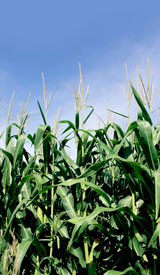


Contacts: Debbie J.R. Cherney, Cornell University,
607-255-2882;
Peter Barney, Cornell Cooperative Extension of St. Lawrence County,
315-379-9192
Research Shows Wide Swath Haymaking Can Produce Faster,
Higher Quality, Less Costly Forage
Farmers in New York are changing the way they make hay. Research by
Cornell University researchers and its Cornell Cooperative Extension
educators, working with funds from the Northern New York Agricultural
Development Program (NNYADP) and the New York Farm Viability Institute,
Inc. suggests farmers can use wide swath mowing to shorten the drying
time and increase the quality of their forage. Wide swath mowing spreads
the cut forage out to 90 percent or more of the cut width, creating up
to three times more sun exposure compared to narrow windrows.
Wide swathing research pioneer Thomas F. Kilcer, of Cornell Cooperative
Extension of Rensselaer County says with the right weather, some
wide-swathed hay has dried to optimum moisture levels in as little as
three to five hours. In one research trial with unusually dry weather
conditions the drying time of a grass crop to ready-to-chop levels was
recorded as less than one hour. A narrow swathed crop can take days to
dry and is at risk of complete loss due to prolonged exposure to wet
weather.
Kilcer says, �There is a potential gain of 300 lbs. worth of milk
production in every ton of dry matter fed as wide-swathed silage. The
traditional harvest system of narrow swath mowing (windrowing) works
counterproductive to making optimum haylage in a timely manner. Work by
various researchers has shown that the early drying stage right after
cutting significantly impacts the carbohydrate levels remaining in the
forage by the time it reaches the cows.�
A higher sugar content in the forage encouraged by the wide swath
harvesting and quick drying technique increases the quality of the
forage for dairy cows and supports the potential for increased milk
production.
Kilcer cites a report of a Rensselaer County farmer who was able to
reduce his grain costs by 3 lbs per cow per day by feeding wide-swathed
haylage. That farmer saw an increase in milk production of 4 lbs of milk
per cow per day.
Debbie J.R. Cherney, an associate professor of Animal Science at Cornell
University, Ithaca, NY, served as project leader for a wide swathing
project in Northern New York. She says, �Photosynthesis continues after
the grass is cut. The overnight loss of sugars in the hay is eliminated
by rapid drying and same day cutting and ensiling.�
Jon Greenwood of Greenwood Dairy, Canton, one of two farmers
participating in the Northern New York wideswathing project, says, �The
take-home message is that working with our existing manpower, equipment
and timeline, we need to mow our hay as widely as we can to speed up the
drying time. Anyone who can cut and ensile a high quality forage in one
day has an important advantage over the uncertainty of the weather.�
For Bernie Moulton of Madrid who harvests his own hay and custom cuts
for other farmers with his brother-in-law, says, �We have a very narrow
window of time to get all of our customers� fields cut, so we have to
keep moving when the weather is right. This year if we are mowing on a
cloudy, cool day, we will use our hay tedder to scatter the hay out for
faster drying and then rake it in windrows to chop the same day.�
Conditioning Not Needed for Silage
Working on the two Northern New York farms using equipment supplied by
Kuhn Farm Machinery, Inc. in Vernon, NY, the NNYADP-funded research team
cut forage with 9-foot-wide disc mowers with and without conditioners
and a mower fitted with a wide swathing kit made for mowers in Europe by
Kuhn Equipment of France. The kit allows production of both wide and
narrow conditioned swaths. Conditioning forces the moisture out of cut
stems and leaves.
Fields of reed canarygrass with less than 20 percent alfalfa and of
50-50 alfalfa-orchardgrass mix were cut at Moulton�s Paradise Valley
Farm. A field of 90 percent alfalfa was cut at Greenwood�s.
Four treatments were applied: mowing without conditioning into wide
swaths, mowing with conditioning into wide swaths, mowing with
conditioning into narrow swaths, and mowing with conditioning into
narrow swaths immediately followed by tedding into wide swaths. The wide
swaths covered 90 to 100 percent of the mowed row covered in one pass of
the mower. A Kuhn gyro-tedder was used to spread a narrow-conditioned
swath out to 100-percent of the mower width. A rotary rake was used to
windrow all cuts at the appropriate time.
New York State Forage Specialist Dr. Jerry H. Cherney, says, �The wide
swath treatments reached desired silage moisture levels the day of
cutting. The conditioned narrow swath immediately tedded into a wide
swath dried the fastest of all treatments. No differences were detected
in the drying rates between conditioned and unconditioned wide swaths.�
Cherney, a Cornell University Crop and Soil Sciences professor, says no
differences were detected in the drying rates between conditioned and
unconditioned wide swaths. �Eliminating conditioning from the haymaking
process reduces power output and lowers fuel costs.�
Cherney concludes, �Wide swath mowing to ninety percent or more of the
cut should consistently result in dry down to silage moisture on the
same day when mowing on a day with reasonable drying conditions.�
Results from the trial on the alfalfa field at Greenwood�s dairy farm
showed that the conditioned narrow swath tedded into a wide swath
reached 65 percent moisture in 5.3 hours and total sugars were 23
percent higher compared to the conditioned wide swath. The conditioned
and unconditioned wide swaths reached 65 percent moisture in 6.6 hours.
The conditioned narrow swath took more than eight hours to reach 65
percent moisture, making same-day ensiling unlikely.
The fiber digestibility in the conditioned narrow swath tedded into a
wide swath and in the unconditioned wide swath was 36 g/kg higher than
the narrow swath.
For more information on the Northern New York Agricultural Development
Program, go online to www.nnyagdev.org.
# # #
